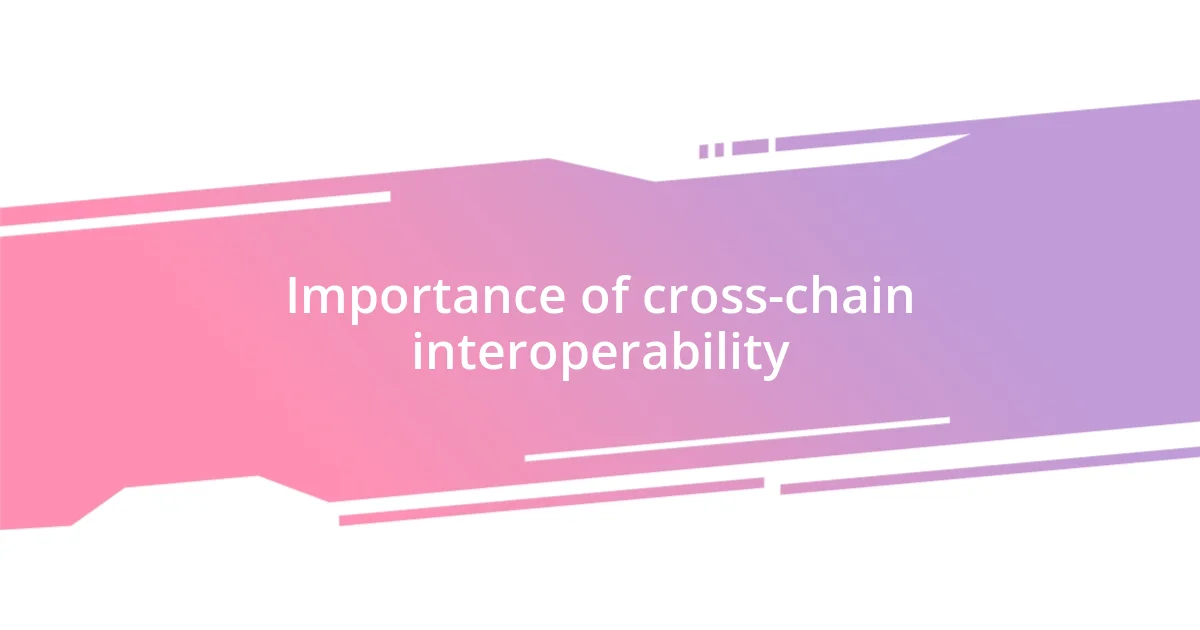Key takeaways:
- Cross-chain DeFi enhances liquidity and accessibility, allowing users to interact with diverse financial products across multiple blockchains.
- Key technologies such as atomic swaps, interoperability protocols, and cross-chain bridges are crucial for facilitating efficient transactions and asset transfers between different networks.
- Despite its potential, cross-chain DeFi faces challenges like security risks, lack of standardization, and user experience complexities that need addressing for widespread adoption.

Understanding cross-chain DeFi
Cross-chain DeFi refers to the ability to interact with decentralized finance protocols across different blockchain networks. This concept opens up a world of possibilities; I remember the first time I transferred assets from Ethereum to Binance Smart Chain seamlessly. It felt empowering, like having the key to a vast financial universe that was previously off-limits.
The beauty of cross-chain DeFi lies in its potential to enhance liquidity and reduce barriers to entry. Imagine being able to access unique financial products from any blockchain without needing to worry about being confined to one network. I often wonder, how many opportunities have we missed in the past simply due to our reliance on a single blockchain?
By leveraging technologies like atomic swaps and bridges, cross-chain DeFi enables users to engage in activities that were once cumbersome. I’ve personally experienced the thrill of swapping tokens across chains in just minutes, which made me realize how much simpler this ecosystem is becoming. What about you? Have you ever thought about how such innovations can change your financial strategies?

Importance of cross-chain interoperability
Interoperability between different blockchains is essential for creating a cohesive DeFi landscape. I vividly recall the confusion I felt when trying to navigate the fragmented world of decentralized finance—so many projects were promising great things, yet most of them were locked away in their own silos. This experience made me realize how cross-chain interoperability can transform our financial interactions, bridging gaps and allowing for more cohesive financial strategies.
- Expands access to a wider range of financial products and services
- Enhances liquidity by pooling resources from various blockchains
- Minimizes the risks associated with investing in isolated ecosystems
- Encourages innovation by fostering collaboration across different blockchain projects
- Promotes user confidence in the DeFi space by creating a seamless experience
Understanding the importance of cross-chain interoperability fundamentally changes the way I approach DeFi. It’s thrilling to think about the flexibility and freedom it offers, making it easier for anyone to participate in this evolving space. Each new opportunity to transact across platforms reinforces my belief that the future of finance will be deeply interconnected, enhancing both accessibility and user experience in ways we’ve only begun to explore.

Key technologies enabling cross-chain DeFi
When I first delved into cross-chain DeFi, the technology that stood out to me was atomic swaps. These swaps allow for the direct exchange of one cryptocurrency for another without the need for a centralized intermediary. I remember successfully swapping Bitcoin for Ethereum, and it felt revolutionary—like being part of a decentralized marketplace where I was in control of my transactions. It’s incredible to think how this technology empowers users to bypass traditional barriers and trade freely, don’t you think?
Another key technology that’s reshaping the cross-chain landscape is the emergence of interoperability protocols like Polkadot and Cosmos. These projects began to resonate with me deeply when I realized they could harmonize multiple blockchains, functioning as a backbone that connects different networks effortlessly. I’ve seen firsthand how these systems have opened new avenues, multiply the options available in DeFi, and even facilitate lending across platforms, all in a matter of clicks!
Lastly, I can’t overlook cross-chain bridges, which I like to think of as the “highways” of the blockchain world. These tools enable seamless asset transfers between networks, breaking down the walls that once confined us. The ease with which I transferred stablecoins between Ethereum and Solana left me feeling exhilarated. The experience was akin to finding a shortcut through a maze—a moment that made me realize how potent these technologies are in shaping the future of finance.
| Technology | Description |
|---|---|
| Atomic Swaps | Enable direct cryptocurrency exchanges without intermediaries, enhancing user control. |
| Interoperability Protocols | Connect multiple blockchains, facilitating the exchange of information and assets. |
| Cross-Chain Bridges | Allow seamless transfers of assets between different blockchain networks. |

Benefits of using cross-chain DeFi
When I started exploring cross-chain DeFi, I was amazed by the sheer variety of financial products available at my fingertips. It felt like diving into a treasure chest. The ability to access unique services across different blockchains means anyone, from seasoned investors to newbies, can find opportunities that align with their needs. Have you ever found yourself wishing for just one more option? Cross-chain DeFi grants that wish with its expansive ecosystem.
One of the most significant benefits I experienced was the boost in liquidity. Pooling resources from various blockchains creates a deep reservoir of funds available for traders and investors alike. I can vividly recall a moment when I needed to execute a trade quickly; the liquidity provided through cross-chain mechanisms meant I could make a swift transaction without slippage. This flexibility reinforces my belief that cross-chain platforms create an environment that encourages smart, agile financial decisions.
What truly excites me about cross-chain DeFi is how it cultivates innovation. By bridging different blockchain projects, teams are inspired to collaborate and experiment in ways they wouldn’t have considered before. I remember reading about innovative lending protocols that harnessed the strength of multiple networks, showcasing not just creativity but also the potential for significant advancements in finance. Isn’t it invigorating to think about the barriers that are being broken down?

Challenges facing cross-chain DeFi
As I navigated the landscape of cross-chain DeFi, I quickly recognized some daunting challenges. One significant issue is security; with multiple blockchains interacting, the risk of vulnerabilities inevitably increases. I remember hearing about projects that suffered hacks simply because their cross-chain implementations weren’t fortified enough. It made me realize that while the concept is groundbreaking, we can’t overlook the need for robust security measures in these interconnected systems.
Another challenge I encountered is the lack of standardization across different blockchains. Each network operates with its own protocols and governance models, leading to confusion and inefficiencies. I can recall a moment when I was trying to integrate assets from various chains, and it felt like piecing together a jigsaw puzzle with missing pieces. It’s clear that establishing common standards could greatly enhance the user experience and streamline operations in the cross-chain DeFi space.
Lastly, the complexity of using cross-chain platforms can be overwhelming. I’ve experienced firsthand the confusion that comes with navigating various interfaces and transaction processes. Have you ever felt lost when trying to execute a swap or leverage an asset from another blockchain? I certainly have! Simplifying the user journey is critical—if cross-chain DeFi is to be truly accessible, it needs to cater to both tech-savvy users and those just stepping into the crypto world.

Popular platforms for cross-chain DeFi
When I think about popular platforms for cross-chain DeFi, one that immediately comes to mind is ThorChain. It’s fascinating how it allows users to swap assets across different blockchains seamlessly. I still remember the first time I traded Bitcoin for Ethereum through its liquidity pools. The whole process felt like magic—there was no lengthy transaction delay, just a fluid experience that kept me engaged and eager to explore more.
Another platform that stands out is Polygon (formerly Matic). Its ability to connect with Ethereum and other chains truly opens up a world of possibilities. I once had the chance to participate in a yield farming opportunity that was exclusively available on Polygon. The yields were enticing, and diving into those strategies felt like a thrilling adventure—like being part of an elite club that was pushing the boundaries of what’s possible in finance. Have you ever found a hidden gem in the world of crypto that changed your investment approach?
Finally, Uniswap’s cross-chain capabilities have also captured my attention. The way it facilitates decentralized trading across multiple networks is remarkable. I recall a time when I eagerly swapped a token on Uniswap and watched the transaction execute flawlessly, despite the complexities of interacting with various blockchains. It made me appreciate how these platforms are designed to enhance user experience while still pushing the envelope in cross-chain functionality. Isn’t it exciting to see how these developments are reshaping our financial landscape?

Future of cross-chain DeFi innovation
As I dive deeper into the potential of cross-chain DeFi, I can’t help but feel a sense of excitement about the innovations on the horizon. Imagine a future where assets can flow between blockchains almost effortlessly, transforming how we think about liquidity and value. This interoperability could lead to a more inclusive financial landscape—one that invites users from all backgrounds to participate without barriers. Don’t you think that could change everything?
Looking ahead, I see technological advancements, like improved interoperability protocols and decentralized exchanges, driving this innovation. I remember attending a webinar where experts discussed the next generation of cross-chain bridges. The possibilities they outlined were truly inspiring! Just think about being able to leverage a diverse range of assets seamlessly, allowing for more complex financial strategies without the heavy lifting that we often see today. How much more could we achieve if managing assets across chains became as easy as sending an email?
Moreover, user experience is going to be a focal point in future advancements. I’ve often felt overwhelmed by the myriad of options available across chains. The idea of creating intuitive, user-friendly interfaces excites me. If developers harness design thinking to streamline these platforms, even the newest users would feel empowered to participate. Have you ever imagined what it would be like to engage with DeFi without any confusion? This vision makes me hopeful for a more accessible future in the cross-chain DeFi ecosystem.














